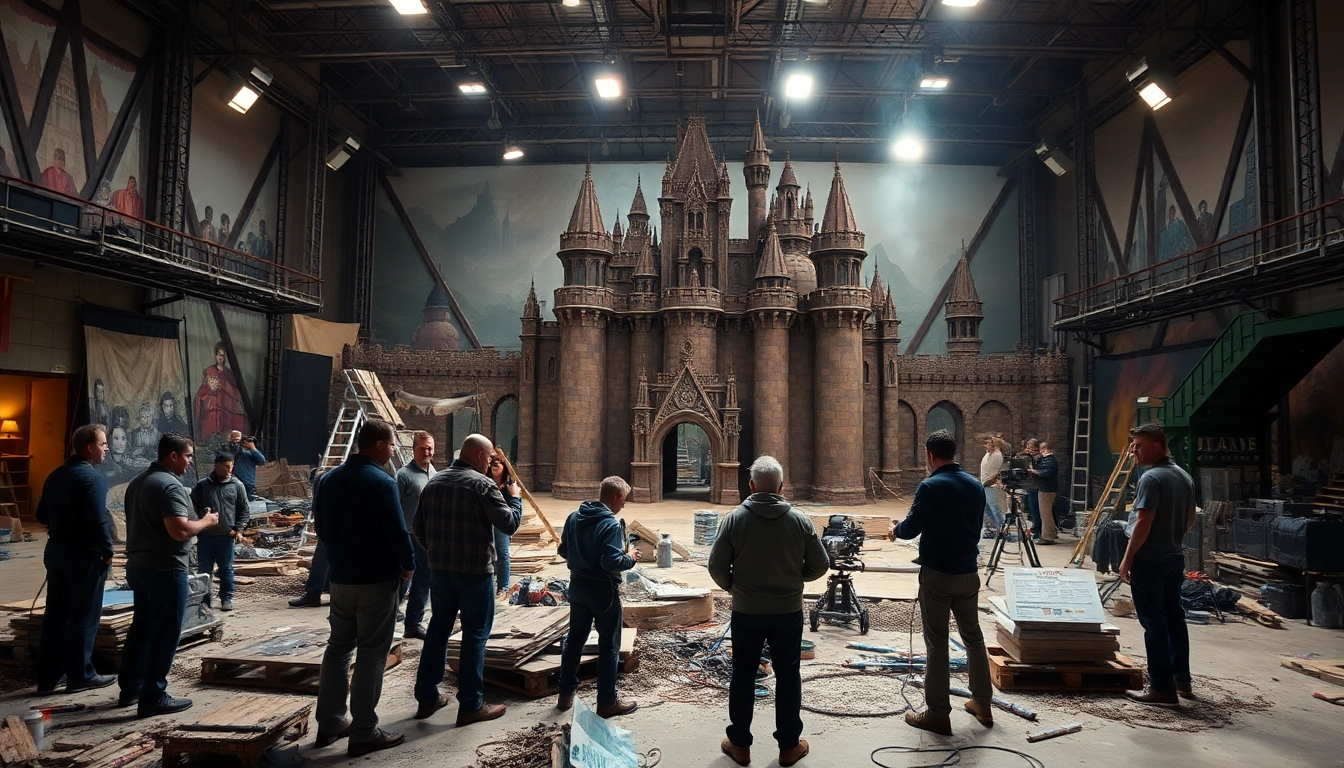Understanding Movie Sets
When it comes to filmmaking, the term movie sets is often heard but not fully understood. A movie set serves as the backdrop for the actors, a canvas for the cinematographer, and an essential element that helps convey the story’s atmosphere. In this section, we will delve into what movie sets are, their significance in production, and the various types that exist in the industry.
Definition and Importance of Movie Sets
A movie set is defined as an artificially constructed environment that mimics real-world locations or imaginative spaces designed for filming. These sets play a critical role in storytelling, providing a visual context that helps immerse the audience in the film’s world. For instance, the grand castle set in a fantasy film or the cramped apartment set in a romantic drama not only influences the narrative but also impacts the actors’ performances.
Types of Movie Sets: From Modular to Permanent
Movie sets can be broadly categorized into several types based on their construction and usage:
- Modular Sets: These are pre-fabricated pieces that can be easily assembled and disassembled. Their flexibility allows filmmakers to shoot in various configurations without the need for extensive construction efforts.
- Permanently Constructed Sets: Some films require sets that are built to last, often seen in theme parks or studios where the sets can be used for multiple productions over the years.
- On-Location Sets: Instead of building sets, filmmakers may choose to shoot in real environments that align with their story, utilizing available landscapes while enhancing them with props and light manipulation.
Each type of movie set serves a distinct purpose, tailored to various genres, budgets, and creative objectives. The choice of set influences the production team’s workflow and the overall aesthetic of the film.
The Role of Art Direction in Movie Sets
Art direction is integral to creating an effective movie set. The art director is responsible for the visual aspects, guiding the set design to ensure it adheres to the film’s tone and vision. They collaborate with the director, costume designer, and cinematographer to create a cohesive look that enhances the storytelling. The details in the set design—from colors and textures to furniture and props—are meticulously curated to evoke specific emotions and establish believability. A well-designed set can elicit responses from the audience before a single line of dialogue is spoken.
Designing Movie Sets
The design of a movie set is where creativity meets practicality. It involves a thorough understanding of the script, the characters, and the emotional tone of the story. Below are key aspects to consider when embarking on the set design process.
Initiating the Design Process
The first step in designing a movie set is script analysis, where production designers review the screenplay to extract crucial elements that should be visually represented. Factors such as the setting, time period, and characters’ lifestyles are analyzed, allowing the designer to draft ideas. Concept sketches and mood boards are great tools for visualizing ideas that align with the director’s vision. Collaborating with the director during this phase ensures that the set concept reflects the desired aesthetic and supports the narrative flow.
Incorporating Symbolism and Theming in Movie Sets
Good set design transcends mere aesthetics—it often incorporates symbolism and theming. This can elevate the narrative, making it more engaging for viewers. For example, using color theory can cue the audience into the emotional undertones of a scene, such as using warm hues for affection or cooler tones for tension. Themes can be reinforced through carefully selected props and decor, allowing layers of meaning to be embedded within the environment itself. Such thoughtful integration creates a richer viewing experience and a more profound connection with the film’s themes.
Best Practices for Set Layout and Design
A well-laid-out set must consider aspects such as spatial dynamics and actor movements. Here are some best practices to ensure an effective set design:
- Flow and Accessibility: The layout should facilitate smooth movements for actors and crew while enhancing energy flow within scenes.
- Focal Points: Create visual focal points that guide viewer attention and highlight important elements of the story.
- Practicality: The set should be functional, allowing scenes to be shot efficiently without compromising the visual integrity.
- Lighting Considerations: Design the set with lighting in mind, ensuring that every corner of the space is usable and visually engaging.
Employing these practices helps generate an immersive experience that complements the actors’ performances and enhances the overall production quality.
Building Movie Sets
The transformation from design concept to a tangible movie set requires a careful and systematic building process. This phase is where creativity meets the technical skills necessary for engineering art into reality.
Materials Used in Movie Sets Construction
Construction of movie sets involves a variety of materials chosen for their durability, cost-effectiveness, and suitability to the project’s needs. Commonly used materials include:
- Plywood: Lightweight yet sturdy, plywood is a versatile material often used for building walls and platforms.
- Foam: Often used for creating intricate designs and props, foam can be easily carved to replicate textures and structures.
- Metal and Wood Frameworks: These are utilized for larger structural elements, providing stability while also accommodating safety regulations.
- Fabric: Used for draping and backdrops, fabric can help change the mood of a set drastically through color and texture.
Selecting the right materials ensures that the set can withstand the demands of shooting while achieving the desired visual aesthetic.
Techniques for Efficient Set Building
Efficiency in building movie sets is crucial, particularly in time-sensitive production schedules. Techniques to enhance efficiency include:
- Modular Building: Utilizing pre-made components that can be assembled on-site can drastically cut construction time.
- 3D Modeling Software: Employing software for virtual building can help visualize the set and troubleshoot potential issues before construction begins.
- Collaborative Workflows: Engaging different departments early in the design process encourages innovative solutions and minimizes downtime.
By applying these techniques, production teams can ensure that set construction aligns with the shooting schedule and creative goals.
Safety Standards in Movie Sets Construction
Safety is paramount in every phase of the film production process, especially during set construction. Adhering to safety standards protects the crew, actors, and equipment. Important safety practices include:
- Risk Assessment: Conducting thorough assessments to identify potential hazards before construction begins.
- Proper Training: Ensuring that all crew members are trained in safety protocols and aware of emergency procedures.
- Regular Inspections: Consistently checking the integrity of set structures and equipment to prevent accidents during filming.
These practices foster a safe work environment, allowing the creative process to thrive without unforeseen interruptions.
Utilizing Movie Sets for Production
When filming begins, having a well-designed and constructed movie set is essential to ensure that production goals are met effectively. This phase encompasses multiple strategies for optimizing the use of movie sets.
Strategies for Filming on Movie Sets
Filming on a dedicated movie set can facilitate various strategies aimed at enhancing production quality. Some effective tactics include:
- Schedule Deliberately: Prioritize scenes that take place in the same location to maximize the efficiency of the shooting schedule.
- Pre-visualization: Use storyboards and pre-shot planning to ensure that every angle and type of shot is well thought out prior to filming.
- Lighting Planning: Establish lighting setups that complement the set design for each scene to maintain continuity and visual appeal.
These methods help streamline the filming process, ensuring that creative visions are effectively captured on camera.
Maximizing the Visual Impact of Movie Sets
Distinctive movie sets can significantly enhance the visual storytelling of a film. To maximize their impact, filmmakers can consider:
- Dynamic Angles: Encourage “set-orientated” camera movements that highlight the details of the environment, providing depth to the scenes.
- Cinematic Color Palettes: Leverage color grading in post-production to enhance the visual themes established by the set design.
- Set Interaction: Design sets that encourage interaction between the actors and their environment to enhance performance authenticity.
These strategies contribute to creating memorable cinematic moments, deepening the audience’s emotional connection to the film.
Post-Production Considerations for Movie Sets
While the shooting phase concludes, the influence of movie sets does not end. They play a pivotal role in post-production processes such as editing, sound design, and visual effects. Key considerations include:
- Continuity Checking: Ensure that all sets maintain visual consistency throughout different takes and angles during editing.
- Set Extensions: Visual effects can enhance movie sets by digitally extending them or adding elements that were not physically present during filming.
- Sound Design: Incorporate ambient sounds from the set environment that align with the visuals, helping to create an immersive experience.
By paying attention to these details during post-production, filmmakers can ensure that the vitality of the sets continues to resonate throughout the final product.
Innovations in Movie Sets
As technology advances, so do the methodologies and techniques used in movie set creation. Emerging innovations are shaping the future of how movie sets are designed, constructed, and utilized in production.
Emerging Technologies Impacting Movie Sets
New technologies are revolutionizing the film industry, particularly within the realm of movie sets. Some noteworthy advances include:
- Virtual Production: Techniques utilizing real-time rendering engines allow filmmakers to visualize sets in immersive environments, enabling on-the-fly adjustments during filming.
- Augmented Reality (AR): AR technology can create interactive set elements that enhance storytelling by allowing filmmakers to interact with virtual elements in real space.
- 3D Printing: This technology enables the rapid creation of props and set pieces, significantly reducing turnaround times and costs associated with traditional fabrication.
These innovations not only improve efficiency and creativity but also elevate the visual storytelling experience for audiences.
Case Studies: Revolutionary Movie Set Designs
Several groundbreaking films have pushed the boundaries of traditional movie set design, serving as excellent examples of innovation in practice. For instance:
- Gravity: The use of sophisticated rigging and digital backgrounds allowed filmmakers to create a realistic portrayal of outer space, leading to a highly immersive experience.
- The Mandalorian: This series employed a groundbreaking virtual production stage known as “The Volume,” combining physical and digital environments to enhance visual fidelity in real time.
- Life of Pi: Innovative set design and visual effects combined to create a lifelike experience on the ocean, where CGI blended seamlessly with practical elements.
These case studies highlight how embracing innovation in set design can lead to extraordinary cinematic achievements, inspiring future filmmakers to explore new avenues in storytelling.
Future Trends in Movie Sets Construction and Design
Looking forward, several trends are poised to shape the future of movie sets:
- Sustainability: Eco-friendly materials and practices are becoming increasingly important in set design as the industry prioritizes environmental awareness.
- Technological Integration: Continued advancements in CGI and virtual reality will enhance traditional set designs, enabling filmmakers to create visually stunning narratives.
- Community Collaboration: Local communities are becoming more involved in the filmmaking process, leading to a deeper connection between film and audience.
These trends signify a dynamic shift in the film industry, setting the stage for innovative and responsible practices that cater to both filmmakers and viewers alike.


